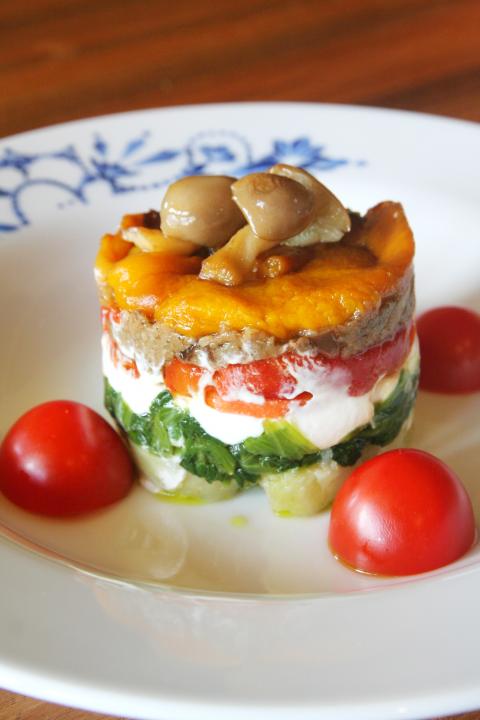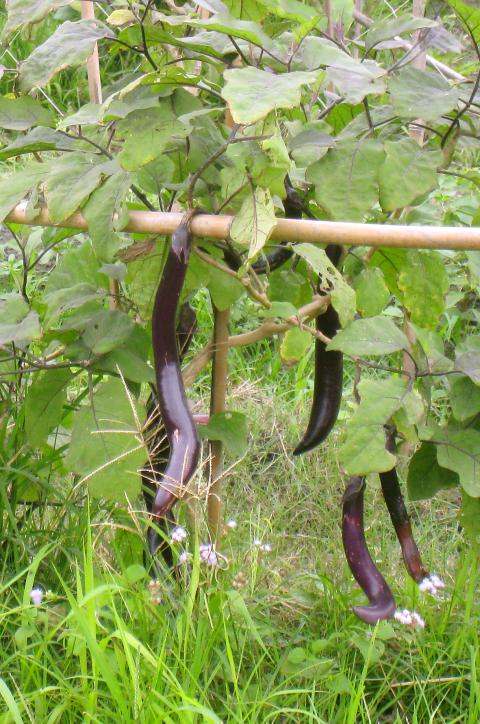Aubergines can be found in a bewildering range of varieties from the bulbous purple globes most often associated with Mediterranean cuisine, but confusingly called Japanese Aubergine in Taiwan (日本茄子), to plump ivory ovals popular in the US (it is this white variety that is responsible for the aubergine’s other common name, the eggplant). In Taiwan, the most commonly available is a long tubular variety. Compared to its larger, plumper cousins, it lacks the visual appeal as something that can hold its own on a plate, but it is full of flavor and it is perfect stewed or made into a paste.
Technically, the aubergine is a fruit, though its primary usage around the world is as a vegetable, much like the tomato, to which it is related. In this role it is extremely versatile, forming the basis for many classic dishes from Thai curries, the famous French ratatouille, the Italian parmigiana di melanzane (eggplant parmigiana), to versions of middle-eastern moussaka.
Aubergines are widely used in Taiwanese cuisine, with one of the most popular presentations being the spicy aubergine with minced pork (魚香茄子), which has the confusing literal name of “aubergine with fish flavor,” despite containing not a single item from the ocean. This is a wonderfully flavorsome dish when prepared well, but though the aubergines get to show off its amazing texture, the spicy “fish flavor” doesn’t give much chance for the vegetable to express itself flavor-wise.

Photo: Ian Bartholomew
Another issue with dishes such as spicy aubergine with minced pork and other similar fried preparations is the sponge-like manner that the vegetable sucks up oil, and careless preparation can lead to the creation of sodden, oily mush. Salting the vegetable does help reduce how much oil is absorbed. Precooking, such as roasting or cooking in a liquid, can do the same.
In my early days as a cook, I was always a little intimidated by the aubergine because of its reputation as a difficult vegetable to prepare well. Since then I have discovered the very rich and varied flavors and textures that it can contribute to all kinds of cooking. Deep fried, it can be crisp and succulent. Grilled, it has a lovely smoky aroma. And when stewed, it becomes soft and luscious.
In addition to its culinary benefits, the aubergine is regarded by some as one of the healthiest foods around. It provides a huge variety of vitamins and minerals, including folate, potassium and manganese, as well as vitamins C, K, and B6, phosphorus, copper, thiamin, niacin, magnesium, and pantothenic acid. It is also a good source of dietary fiber. It is also said to have high levels of antioxidant phenolics, which are supposed to help prevent cancer and protect brain cell membranes. What more could you want from a cheap and easily available vegetable?

Photo: Ian Bartholomew
As a member of the nightshade family (which includes tomatoes and potatoes), aubergine can spark allergic reactions that include itchy skin or mouth, mild headaches and stomach upset. This is particularly related to the raw or unripe fruit, and it is widely suggested that except in quite rare instances, cooking will preclude an allergic reaction in most people.
Chunky Aubergine Puree
This is a rather simple take on the classic Arab dish baba ghanoush, but I avoid calling it by this name as so many people associate the dish with the use of tahini, the sesame paste that is such an integral part of North African and Middle Eastern cooking. Authentic tahini is not easily available in Taiwan, and attempts to use Taiwanese sesame seed paste have yielded acceptable, if not particularly memorable, results.
Ingredients
3-4 aubergines
half tsp cumin, ground
half tsp coriander seed, ground
half tsp dried chili flakes
1 clove of garlic, minced
Olive oil
A squeeze of lemon juice
Salt and pepper to season
Directions
1. Preheat an oven to 200c. (Many traditional Middle Eastern cookbooks recommend using a charcoal brazier to roast the skins, a procedure that produces a lovely smoked flavored that enhances the taste of the aubergine beautifully, but is certainly not conducive to ease-of-preparation.)
2. Poke a few holes in the aubergine with a fork or skew er, as you might a sausage, and place on a baking tray in the oven. Cook for about 30 minutes, turning once or twice until the skins become dark and crisp.
3. Cut open and scrape out the flesh of the aubergine onto a chopping board. Roughly chop. (For a smooth puree, a blender or food processor can be used, but I have always preferred a rougher texture).
4. Mix the chopped aubergine with the cumin, coriander, salt, pepper and chili flakes.
5. Gently heat some good olive oil in a pan and add the minced garlic. Keep the heat low and stir until fragrant. Add the aubergine. Fry over low heat, adding more seasoning if required. Add more oil if the mixture becomes too dry. Cook for about 10 minutes until the flavors are well integrated. Near the end of cooking, add lemon juice to taste. Can be served warm or at room temperature.
6. It can be used simply as a spread on bread, to provide moisture in a sandwich, or in more elaborate vegetable dishes such as the vegetable stack (pictured), in which it is combined with boiled potato, spinach puree, yogurt, sweet peppers and mushrooms.
Ian Bartholomew runs Ian’s Table, a small guesthouse in Hualien. He has lived in Taiwan for many years writing about the food scene and has decided
that until you look at farming, you know nothing about the food you eat. He can be contacted at Hualien202@gmail.com.

This year will go down in the history books. Taiwan faces enormous turmoil and uncertainty in the coming months. Which political parties are in a good position to handle big changes? All of the main parties are beset with challenges. Taking stock, this column examined the Taiwan People’s Party (TPP) (“Huang Kuo-chang’s choking the life out of the TPP,” May 28, page 12), the Democratic Progressive Party (DPP) (“Challenges amid choppy waters for the DPP,” June 14, page 12) and the Chinese Nationalist Party (KMT) (“KMT struggles to seize opportunities as ‘interesting times’ loom,” June 20, page 11). Times like these can

June 23 to June 29 After capturing the walled city of Hsinchu on June 22, 1895, the Japanese hoped to quickly push south and seize control of Taiwan’s entire west coast — but their advance was stalled for more than a month. Not only did local Hakka fighters continue to cause them headaches, resistance forces even attempted to retake the city three times. “We had planned to occupy Anping (Tainan) and Takao (Kaohsiung) as soon as possible, but ever since we took Hsinchu, nearby bandits proclaiming to be ‘righteous people’ (義民) have been destroying train tracks and electrical cables, and gathering in villages

Dr. Y. Tony Yang, Associate Dean of Health Policy and Population Science at George Washington University, argued last week in a piece for the Taipei Times about former president Ma Ying-jeou (馬英九) leading a student delegation to the People’s Republic of China (PRC) that, “The real question is not whether Ma’s visit helps or hurts Taiwan — it is why Taiwan lacks a sophisticated, multi-track approach to one of the most complex geopolitical relationships in the world” (“Ma’s Visit, DPP’s Blind Spot,” June 18, page 8). Yang contends that the Democratic Progressive Party (DPP) has a blind spot: “By treating any

Swooping low over the banks of a Nile River tributary, an aid flight run by retired American military officers released a stream of food-stuffed sacks over a town emptied by fighting in South Sudan, a country wracked by conflict. Last week’s air drop was the latest in a controversial development — private contracting firms led by former US intelligence officers and military veterans delivering aid to some of the world’s deadliest conflict zones, in operations organized with governments that are combatants in the conflicts. The moves are roiling the global aid community, which warns of a more militarized, politicized and profit-seeking trend